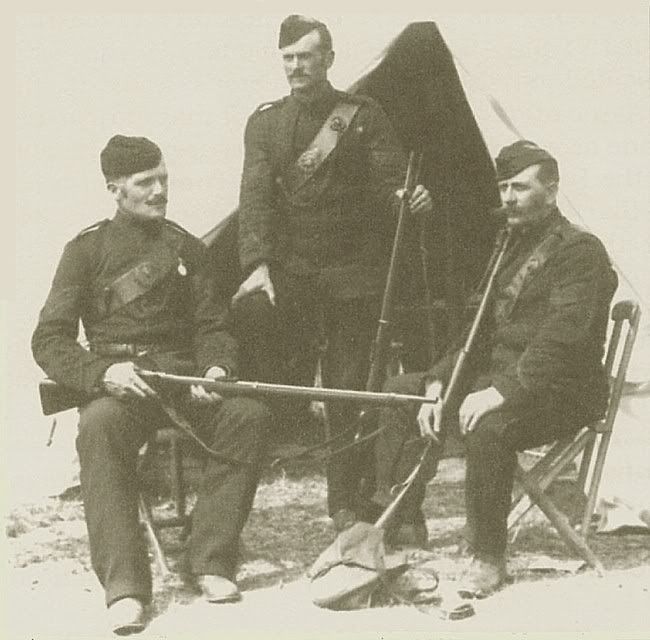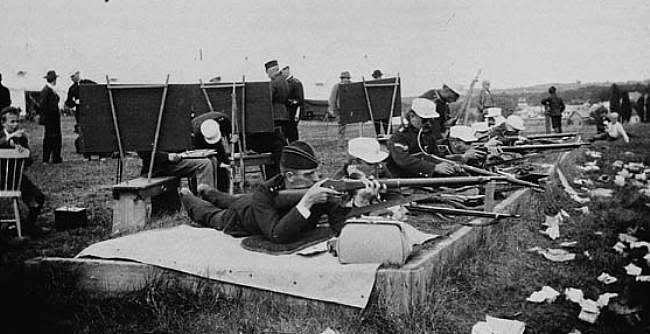In a recent private message to me, Sir Charles deMouton-Black asked:
"A question regarding the QOR and the Martini. I've heard that Canada never adopted the Martini as a a general issue arm. An exception might be the handfull of Martini's purchased by the NWMP. I know the Martini was available during the North West Rebellion, but not likely carried. Is there any evidence to the contrary?
.........
Didn't Canada go straight from the Snider to the Lee-Metford for general issue?"Sir Charles has suggested that my response to him might be of some interest if posted here .....
First, just a bit of background, in summary:
- Canada's Militia were among the first troops in the British Empire to be equipped with the Snider breechloading conversion of the Enfield rifle musket, which only became available in quantity in late 1866. As a result of the perceived need to re-equip with breech-loaders, to meet the threat of the Fenian Raids from south of the border, all of Canada's Volunteer Militia battalions had been armed with the Snider by the end of 1867.
- that having been accomplished, Canada kept the Snider in service as its general issue rifle until the late 1890's.
- Canada did acquire some Martini-Henry rifles - 2,100 Mark I rifles in 1874, and 5,000 Mark III rifles in 1885. Although they were never general issue, they did see some use with Canadian forces, even in combat during the 1885 North West Rebellion .....
Now my response to Sir Charles' question .....I imagine that your question may be triggered by my use of a Martini as my battle rifle during GAF shoots .... Wink
You are correct that Martini-Henry rifles were never general issue in Canada, and we in fact went from the Snider-Enfield to the Magazine Lee-Enfield (not Lee-Metford) for general issue in about 1896-98 (though it apparently took until about 1905 for all Militia battalions to have all their Sniders replaced!
The NWMP were supplied with 10 Martini-Henry rifles in 1874, in lieu of M-H cavalry carbines they had requested for trials. (The carbines were not in fact available for issue even to the British Army until 1877, and none were ever supplied to the Mounted Police.)
However, some Martini-Henry rifles were in fact issued militarily in Canada:
- at least 100 to the Royal Military College in 1876, where it was used by the cadets until 1896.
- at least 85 to 'C' Company of the Infantry School Corps for service during the North West Rebellion in 1885 - strength of the Company in the field during the Rebellion was 4 officers and 85 other ranks. (The Infantry School Corps was one component of the very small .... 750 men, all ranks and all branches .... full-time "Permanent Militia" which had been authorized in 1883 - the closest thing Canada had to a professional army back then. It later became The Royal Canadian Regiment .....)
[In my response to Sir Charles, I erroneously stated that the total strength of the Permanent Militia when first established was 1,000 men - but the maximum authorized strength was not increased to 1,000 until 1886, following the 1885 North West Rebellion.]The authors of "Prairie Fire:The 1885 Northwest Rebellion" made the following wholly undocumented statement therein: "Only enough Martini-Henrys could be obtained to equip one company of the 90th Winnipeg Rifles immediately." David Edgecombe, in "Defending the Dominion: Canadian Military rifles, 1855-1955" indicates that no record was located during his extensive research to support this assertion, and he expresses grave doubts that a unit, the whole strength of which was mobilized and sent into action, would even consider re-arming only one company of its strength with a completely unfamiliar weapon at such a time.
The logistics records for the 1885 campaign reveal that 3,000 rounds of Martini-Henry ammunition were issued to the Supply Officer at Qu'Appelle for re-supply purposes. It accordingly seems doubtful that anybody besides 'C' Company of the Infantry School Corps had Martini-Henry rifles during the campaign, since that would amount to only about 35 rounds per man, if they had only 85 rifles in the field.)
- Actually, the most common issue in Canada of Martini-Henry rifles was for target shooting - to Rifle Associations and the competition shooting teams of Militia Battalions, because it became the standard competition rifle for Empire rifle matches once it supplanted the Snider-Enfield as the primary issue rifle of the British Army. Some photographs - note the litter of paper wrappers in front of the raised firing point in the third photo. Competition rules required the use of service-issue ammunition, which was supplied in 10-round paper-wrapped packets ......
Three members of the shooting team of the Queen's Own Rifles of Canada ....

The full Queen's Own Rifles of Canada team - Commissioned Officers with silver accoutrements on their cross-belts, NCO's with blackened bronze ....

Competition at the Connaught Rifle Range outside Ottawa .... still the primary shooting facility in Canada ....
